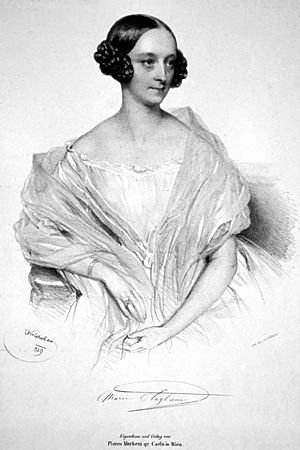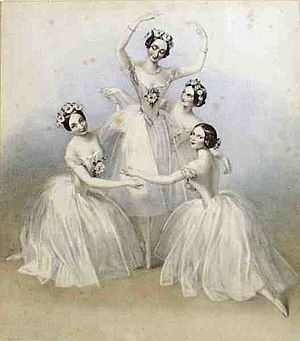Marie Taglioni facts for kids
Quick facts for kids Marie Taglioni |
|
|---|---|
| Comtesse de Voisins | |
 |
|
| Taglioni in an 1839 lithograph | |
| Spouse(s) | Comte Auguste Gilbert de Voisins |
| Issue | |
| Georges Philippe Marie Gilbert de Voisins Eugenie Marie Edwige Gilbert de Voisins |
|
| Father | Filippo Taglioni |
| Mother | Sophie Karsten |
| Born | 23 April 1804 Stockholm, Sweden |
| Died | 22 April 1884 (aged 79) Marseille, France |
| Occupation | danseuse |
Marie Taglioni, Comtesse de Voisins (born April 23, 1804 – died April 22, 1884) was a very famous ballet dancer. She was born in Sweden and had Italian roots. Marie Taglioni was a key figure in the Romantic ballet era, a time when ballet became more about feelings and stories.
She spent most of her life in Austria and France. Marie was one of the most celebrated ballerinas of her time. She performed at important theaters like Her Majesty's Theatre in London and the Paris Opéra Ballet. Many people believe she was the first ballerina to truly dance en pointe, which means dancing on the tips of her toes.
Contents
Early Life of Marie Taglioni
Marie Taglioni was born in Stockholm, Sweden. Her father, Filippo Taglioni, was a ballet choreographer. Her mother, Sophie Karsten, was also a ballet dancer.
Marie's grandfather, Christoffer Christian Karsten, was a Swedish opera singer. Her grandmother, Sophie Stebnowska, was a Polish opera singer and actress. Marie also had a brother named Paul Taglioni. He was a dancer and choreographer too. They often performed together when they were younger.
Marie Taglioni's Marriage and Family
Marie Taglioni married Comte Auguste Gilbert de Voisins in 1835. However, they separated in 1836.
Marie later had two children. Their names were Georges Philippe Marie Gilbert de Voisins and Eugenie-Marie-Edwige Gilbert de Voisins.
Marie Taglioni's Ballet Training
Marie moved to Vienna, Austria, with her family when she was very young. There, she started her ballet training. She learned from Jean-François Coulon and her father, Filippo.
Her father became the ballet master at the court opera in Vienna. He decided Marie should perform there for the first time. Even though Marie had trained, her father felt her technique needed more work.
So, he created a very strict six-month training plan for her. Marie would hold ballet positions for 100 counts. This training happened every day. Mornings focused on difficult leg exercises. Afternoons focused on slow, graceful movements. These helped her perfect her ballet poses.
Marie had a slightly rounded back and uneven body proportions. She worked very hard to hide these challenges. She improved her flexibility and strength. Marie focused on making her shape and form look perfect to the audience. She was less interested in showing off difficult tricks like many spins. Her first ballet, choreographed by her father, was called "La Reception d'une Jeune Nymphe à la Cour de Terpsichore."
Marie Taglioni's Career Highlights
Before joining the Paris Opéra, Taglioni danced in Munich and Stuttgart. At age 23, she performed in "La Sicilien," another ballet by her father. This performance helped launch her career.
Marie Taglioni became very famous at the Paris Opéra. This happened when her father created the ballet La Sylphide (1832) just for her. This ballet was designed to show off Marie's amazing talent. It was the first ballet where dancing en pointe made sense for the story. Before this, dancing on toes was often just a difficult trick. Dancers would sometimes look awkward doing it. Marie made it look beautiful and natural.
The Famous Pas de Quatre
In 1837, Marie left the Ballet of Her Majesty's Theatre. She signed a three-year contract with the Imperial Ballet in Saint Petersburg, Russia. This ballet company is now known as the Kirov/Mariinsky Ballet.
After her last performance in Russia in 1842, Marie was at the peak of her fame. People loved ballerinas so much that a pair of her pointe shoes were sold for two hundred rubles. This showed how much her fans admired her.
In July 1845, Marie danced in a special ballet called Pas de Quatre. She performed with three other famous ballerinas: Lucile Grahn, Carlotta Grisi, and Fanny Cerrito. Jules Perrot choreographed this ballet. It was created to show Marie's graceful and almost magical dancing style. Pas de Quatre was first performed for Queen Victoria.
Retirement and Later Life
Marie Taglioni stopped performing in 1847. For a while, she lived in a beautiful palace called the Ca' d'Oro in Venice, Italy. Later, when the Paris Opéra ballet was reorganized, she helped guide its new, more professional approach.
She was part of a special six-member jury. This jury judged the first yearly competition for the corps de ballet (the main group of dancers). This competition took place on April 13, 1860.
Marie's only ballet that she choreographed herself was Le papillon (The Butterfly) in 1860. She created it for her student, Emma Livry. Emma Livry is remembered for a sad accident in 1863. Her costume caught fire from a gas lamp used for stage lighting, and she passed away.
Johann Strauss II composed a piece called the "Marie Taglioni Polka." He wrote it to honor Marie Taglioni's niece, who was also named Marie Taglioni. Because they had the same name, people often confused the two women.
Later in her life, Marie taught social dance and ballroom dancing. She taught children and ladies in London, England. She also taught a small number of ballet students. She lived at #14 Connaught Square in London from 1875 to 1876.
Death
Marie Taglioni passed away in Marseille, France, on April 22, 1884. This was just one day before her 80th birthday. Her body was later moved to Paris.
There is some discussion about where she is buried. Some believe she is in Montmartre Cemetery, while others say Père Lachaise Cemetery. Some even think the grave in Montmartre belongs to her mother. Today, dancers often leave their worn-out pointe shoes on the Montmartre grave. This is a way to honor and thank the first great pointe dancer.
See also
 In Spanish: Marie Taglioni para niños
In Spanish: Marie Taglioni para niños
- List of dancers
- Women in dance




